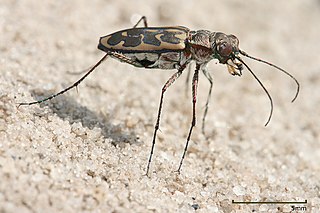
Tiger beetles are a family of beetles, Cicindelidae, known for their aggressive predatory habits and running speed. The fastest known species of tiger beetle, Rivacindela hudsoni, can run at a speed of 9 km/h, or about 125 body lengths per second. As of 2005, about 2,600 species and subspecies were known, with the richest diversity in the Oriental (Indo-Malayan) region, followed by the Neotropics. While historically treated as a subfamily of ground beetles (Carabidae) under the name Cicindelinae, several studies since 2020 indicated that they should be treated as a family, the Cicindelidae, which are a sister group to Carabidae within the Adephaga.

Victor Ivanovich Motschulsky, sometimes Victor von Motschulsky was a Russian entomologist mainly interested in beetles.

Delphacidae is a family of planthoppers containing about 2000 species, distributed worldwide. Delphacids are separated from other "hoppers" by the prominent spur on the tibia of the hindleg.

Latridiidae is a family of tiny, little-known beetles commonly called minute brown scavenger beetles or fungus beetles. The number of described species currently stands at around 1050 in 29 genera but the number of species is undoubtedly much higher than this and increases each time a new estimate is made.
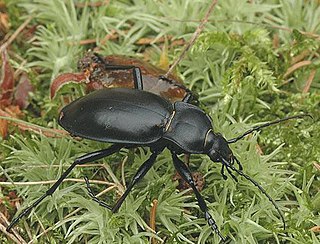
Carabus is a genus of beetles in family Carabidae. The genus is highly diverse with 94 subgenera, 959 species and 2300 subspecies, thus is the largest genus in the subfamily Carabinae. The vast majority are native to the Palearctic, but 16 Nearctic species are also known. Carabus spp. are 12–50 mm (0.47–1.97 in) long, and most species are wingless and often very colourful. These are nocturnal, predatory beetles that feed on snails, earthworms, and caterpillars. Most Carabus species were thought to have inhabited the Eurasian forest, but the species' low dispersal abilities altered the distribution of lineages within the genus.

The Photinini are a large tribe of fireflies in the subfamily Lampyrinae. Photinus pyralis is famous in biotechnology for its luciferase gene. This is sometimes employed as a marker gene; genetically modified organisms which contain it start to glow like the firefly when brought in contact with a luciferin-containing medium. Firefly luciferases differ slightly between taxa, resulting in differently colored light and other properties, and in most cases where "firefly luciferase" is used in some application or study, it is the specific luciferase of P. pyralis.

Harpalus is a genus of ground beetle first described by Pierre André Latreille in 1802.

Melyridae are a family of beetles of the superfamily Cleroidea.

Bembidion is the largest genus of beetles in the family Carabidae by number of species. All species are small and move very fast. Most of them live close to water. The genus has a biantitropical distribution, meaning they are found in both the Northern and Southern Hemispheres, but not in the tropics. In warmer regions it is substituted by closely related Tachys and other genera.

Cymindis is a genus of ground beetle native to the Palearctic, the Near East, and North Africa. It contains the following species:

Platyninae is a subfamily of ground beetles.

Pterostichinae is a subfamily of ground beetles. It belongs to the advanced harpaline assemblage, and if these are circumscribed sensu lato as a single subfamily, Pterostichinae are downranked to a tribe Pterostichini. However, as the former Pterostichitae supertribe of the Harpalinae as loosely circumscribed does seem to constitute a lineage rather distinct from Harpalus, its core group is here considered to be the present subfamily and the Harpalinae are defined more narrowly.

Caelostomus is a genus of beetles in the family Carabidae. It contains the following species:
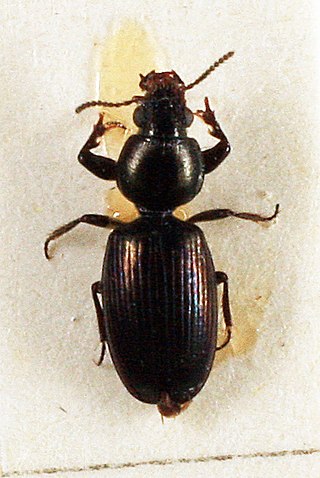
Dyschirius is a genus of beetles in the family Carabidae:
Trechus sculptipennis is a species of ground beetle in the subfamily Trechinae. It was described by Schmidt in 2009.
Caelostomus stevensoni is a species of ground beetle in the subfamily Pterostichinae. It was described by Straneo in 1941.
Caelostomus globulipennis is a species of ground beetle in the subfamily Pterostichinae. It was described by Straneo in 1950.

Bembidiini is a tribe of ground beetles in the family Carabidae. There are more than 120 genera and 3,100 described species in Bembidiini.
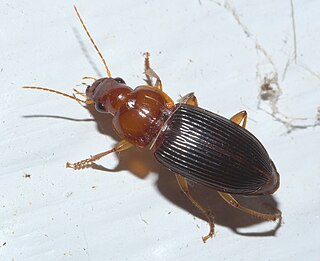
Harpalini is a tribe of a diverse group of ground beetles belonging to the subfamily Harpalinae within the broader family Carabidae. The tribe contains more than 1,900 species.
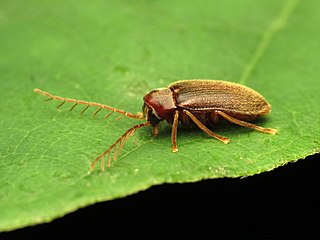
Ptilodactylidae is a family of beetles belonging to the Elateriformia. There around 500 extant species in 35 genera. They are generally associated with riparian and aquatic habitats. The larvae generally live associated with rotting wood or vegetation, or within gravel and detritus on the edge of water bodies. The larvae of some species feed on submerged rotting wood or on plant roots, while the adults of some species are known to feed on fungus with modified brush-like maxillae.
















